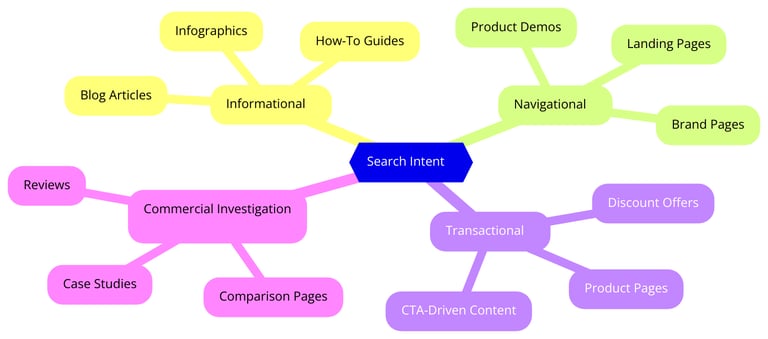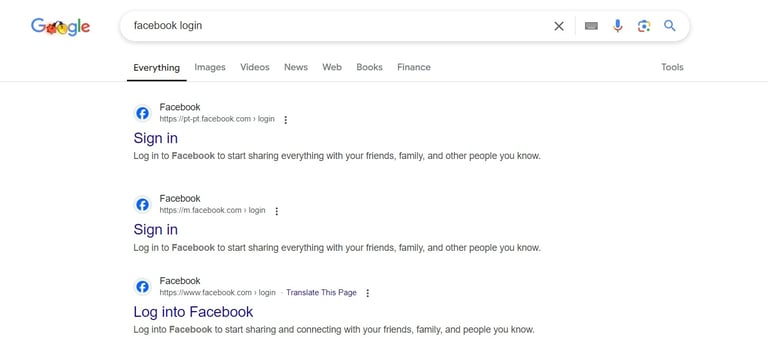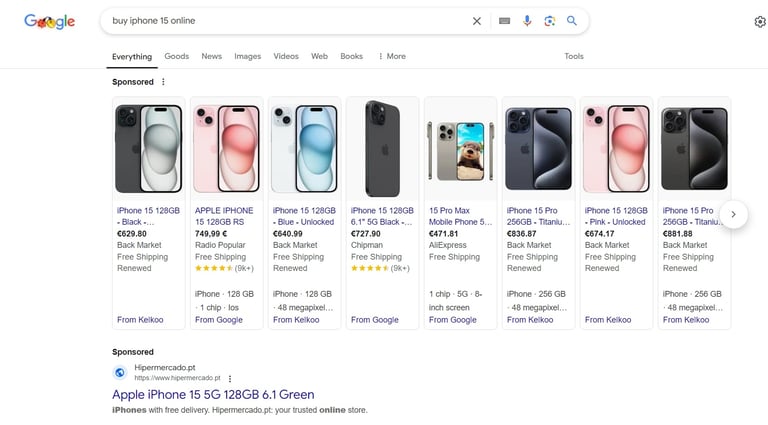
Why search intent matters
Learn why understanding search intent is crucial for meeting users' expectations.
MARKETING & BRANDING



Why search intent matters for SEO
Search intent can transform your content game. It's the secret sauce to connect with your audience and rank higher. Let's understand why search intent is the real MVP of SEO.
What is search intent?
Search intent is the "why" behind every search.
Why did someone type in "how to bake a cake"? Spoiler: they're probably not looking for a history lesson on cake. They want a recipe!
Or how about "buy running shoes"? Yep, that person's ready to spend some cash.
Search intent helps us understand what people want so we can give them exactly that.
Google's Helpful Content Update makes this even more important. This update prioritizes content that genuinely helps users by addressing their questions or needs meaningfully.
It pushes creators to focus on delivering clear, actionable information rather than just meeting keyword quotas.
For instance, a recipe article that not only provides a step-by-step guide but also includes tips for beginners and answers common baking questions is more likely to rank higher, showcasing the shift towards user-centric content.
This means content that truly aligns with user intent is now more likely to rank higher. It's not about stuffing keywords in anymore—it's about being genuinely useful.
Answer the question, solve the problem, or fulfill the need and boom—your content wins.
Why is it important?
Nailing search intent means your content will:
Give people what they want: When you match what someone's looking for, they stick around longer, and your bounce rate takes a nosedive.
Build trust: When you solve their problems, people are more likely to trust and buy from you.
4 types of search intent
Let's break it down. There are 4 main types of search intent, and knowing these is like having a cheat sheet for creating good content—it simplifies content planning by showing you exactly what your audience needs and how to meet their expectations.
Navigational Intent: Someone wants to go somewhere, like "YouTube" or "Facebook login." Make sure your site is easy to find by sprinkling your brand name where it counts.
Informational Intent: They're here to learn—"How to bake a cake," "What is climate change?" For example, a detailed baking guide might include step-by-step instructions, common troubleshooting tips, and a video demo, helping beginners feel confident. Similarly, an educational article on climate change could pair easy-to-read explanations with visuals and links to further resources, making the topic accessible and engaging. Create guides, tutorials, or videos that explain things clearly.
Transactional Intent: Ready to buy? "Buy iPhone 15 online" says it all. Make it ridiculously easy for them to complete the purchase.
Commercial Investigation Intent: They're comparing options, like "Best laptops under $500." Write reviews, comparisons, and lists to help them decide.
How to figure it out
Check keywords
Clues in words: Look for "how to," "best," or "buy." They're dead giveaways.
Context matters: The same keyword can mean different things depending on how it's used.
Tools
Google Trends: Spot what's hot right now.
SEMrush or Ahrefs: Dig deeper into search patterns.
Answer the Public: Find common questions people are asking.
Peek at the SERP
Google's search results page is filled with hints.
For example, the "People Also Ask" section often reveals common questions like "What are the best budget laptops?" or "How do I fix a slow computer?"
You can turn these into engaging content by creating articles, like a guide to the top 5 budget laptops or a troubleshooting checklist for slow computers, tailored to answer these specific questions.
Similarly, featured snippets show the kind of concise, structured answers that Google prioritizes, helping you tailor your content accordingly.
Informational: Look for "People Also Ask" or knowledge panels.
Transactional: Ads or shopping results mean they're ready to buy.
How to match content to search intent
Your mission is to create content that fits like a glove.
Navigational intent
Make it easy for people to find you. Amazon nails this by ensuring "Amazon Prime" searches lead straight to the right page. Take notes.
Informational intent
FAQs, how-to guides, or tutorials are your best friends here. For instance, a home improvement blog might create a "How to Build a Bookshelf" guide with step-by-step instructions, a list of tools and materials, and tips for avoiding common mistakes. Be clear, be helpful.
Transactional intent
Make buying a breeze. Highlight benefits and streamline the checkout process.
Commercial intent
Think comparisons, pros and cons, and detailed reviews. Help them feel confident in their choice.
Use clear headings
Good headings = happy readers. They also make it easier for search engines to understand the structure of your content, which can boost your SEO performance.
Break your content into bite-sized chunks. Mobile users will thank you, and so will Google. Mobile usability is a major factor in search rankings, so making your content easy to read on smaller screens is essential.
Use short paragraphs, bullet points, and larger fonts to improve readability on mobile devices.
Examples
Here's how different industries can nail search intent:
E-Commerce (Clothing): Use "summer dresses" during peak search times. For example, an article could include a style guide showing how to pair dresses with accessories, along with a price comparison for budget-conscious shoppers.
Healthcare (Dental Services): Answer "teeth whitening costs" with detailed FAQs. For instance, include a breakdown of costs by treatment type and tips for maintaining results.
Technology (Smartphones): Write "Best smartphones 2024" reviews. Highlight key features like battery life and camera quality, comparing models side by side.
Local Businesses (Restaurants): Optimize for "Best pizza near me." Add engaging content like a list of your signature pizzas and a map for easy navigation.
B2B (Project Management Tools): Compare features, and write case studies. For example, showcase a detailed case study of how your tool helped a company save time on collaboration.
Common mistakes
Outdated content: Update regularly to stay relevant.
Keyword stuffing: Don't stuff keywords like it's 2010. Focus on value.
Bad UX: If your site's slow or hard to use, you won't have an audience.
Missing the mark: Always align content with what users actually want.
The future of search intent
The game's changing, and AI is leading the charge. Tools like ChatGPT and Bard are helping businesses analyze user behavior and create ultra-personalized content.
Their ability to process vast amounts of data allows businesses to uncover patterns in user behavior, enabling them to create content that resonates with their audience.
For example, ChatGPT has been used in the travel industry to design dynamic itineraries tailored to user preferences, resulting in increased engagement and bookings.
Similarly, Bard has helped e-commerce brands optimize product pages by generating descriptions that directly address customer questions, leading to higher conversion rates.
For example, in the healthcare industry, ChatGPT has been used to create patient-focused FAQs that address common concerns.
At the same time, Bard helps retail companies tailor product descriptions to specific customer queries. For example:
Bard: Generate targeted ad copy for specific search intents.
ChatGPT: Spot recurring themes in user queries to create better FAQs.
And don't forget about voice search. People ask Alexa real questions, like "What's the best budget phone under $300?" or "Where's the nearest Italian restaurant?"
User natural, conversational phrases that people use to speak everyday.
Wrap-up
Search intent is the key to making your content work harder for you. Start by auditing your site with tools like Google Search Console.
Spot those gaps, fill them with user-focused content, and keep refining. It's time to level up your SEO game and give people exactly what they're searching for!
FAQs
What is search intent? Search intent is the purpose behind a user's search query, such as seeking information, making a purchase, or navigating to a website.
Why is search intent important? Understanding intent ensures your content satisfies user needs, improving rankings and engagement.
How do I determine the search intent of a keyword? Analyze keyword modifiers, examine SERP features, and use tools like Google Trends or Ahrefs.
Can search intent change over time? Yes, intent evolves with user preferences, trends, and technological advancements.
How does Google interpret search intent? Google uses AI algorithms like BERT to interpret query context and deliver relevant results.
What can I use to optimize content for search intent? Tools like SEMrush, Ahrefs, and Answer the Public help analyze and align content with intent.








